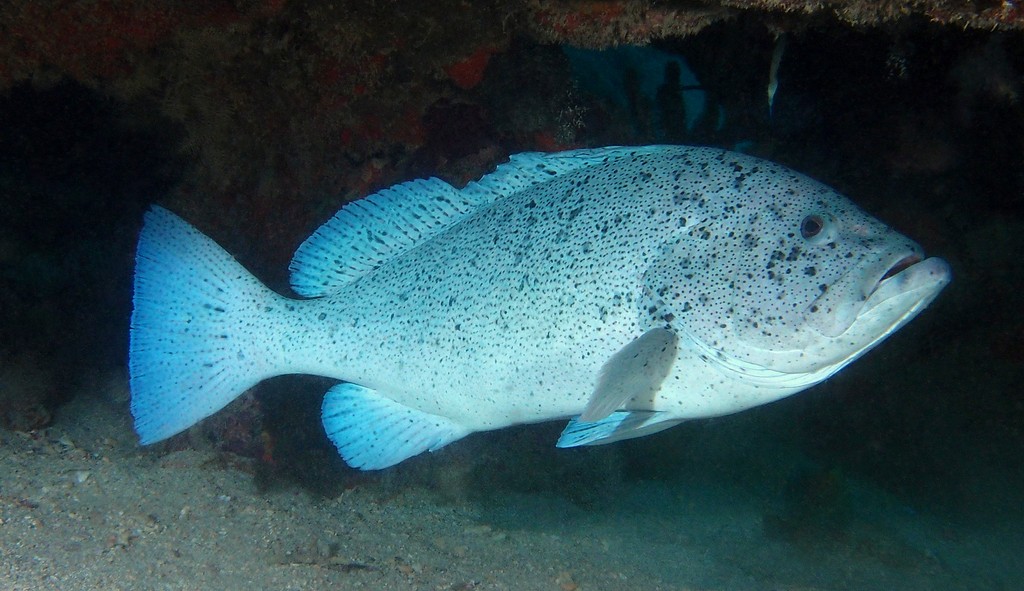EPINEPHELUS CYANOPODUS - (RICHARDSON, 1846)
Actinopterygii (Gigaclass) > Actinopteri (Class) > Teleostei (Subclass) > Perciformes (Order) > Percoidei (Suborder) > Epinephelidae (Family) > Epinephelus (Genus)
Mérou bleu, Loche bleue, Loche morue, Blue maori, Blue maori cod, Coral cod, Purple rockcod, Speckled blue grouper, Speckled grouper, Purple Rockcod, Mero azul, Tsuchihozeri, ツチホゼリ, 細點石斑魚, Cá Mú đốm đen đều,
Synonymes
Epinephalus kohleri (Schultz, 1953)
Epinephelus hoedti (Bleeker, 1855)
Epinephelus hoedtii (Bleeker, 1855)
Epinephelus kohleri (Schultz, 1953)
Epinephelus suitonis (Tanaka, 1915)
Homalogrystes luctuosus (De Vis, 1882)
Serranus cyanopodus (Richardson, 1846)
Serranus hoedtii (Bleeker, 1855)
Serranus punctatissimus (Günther, 1859)
Color
Light bluish grey with numerous very small black spots and scattered larger blackish spots on head, body and fins. Juveniles are mostly yellow becoming gray with dark spots anteriorly. The gray area increases with increasing size until only the fins remain yellow on individuals of 15 to 20 cm. Subadults and large juveniles lack the larger dark sport and may have a broad submarginal black band posteriorly on the caudal fin and black-tipped pelvic fins.
Etymology
Epinephelus: from prefix Greek, epi = upon, on, over, near, at, before, after + from Greek, Nephos = cloud. Referring to film or membrane eye of most if not all groupers known to Bloch (although modern accounts mention only a transparent cornea protruding slightly through the orbit); Bloch also provided three vernacular names that describe the eyes: Blödaugen, German for “stupid eyes” or “bleary eyes,” depending on the translation, the English “Wall-eye,” and the French Tayes (per Bloch 1797), from taie, an opaque spot on the cornea.
Mérou bleu, Loche bleue, Loche morue, Blue maori, Blue maori cod, Coral cod, Purple rockcod, Speckled blue grouper, Speckled grouper, Purple Rockcod, Mero azul, Tsuchihozeri, ツチホゼリ, 細點石斑魚, Cá Mú đốm đen đều,
Synonymes
Epinephalus kohleri (Schultz, 1953)
Epinephelus hoedti (Bleeker, 1855)
Epinephelus hoedtii (Bleeker, 1855)
Epinephelus kohleri (Schultz, 1953)
Epinephelus suitonis (Tanaka, 1915)
Homalogrystes luctuosus (De Vis, 1882)
Serranus cyanopodus (Richardson, 1846)
Serranus hoedtii (Bleeker, 1855)
Serranus punctatissimus (Günther, 1859)
--------------------------
Description
Dorsal spines (total): 11; Dorsal soft rays (total): 16-17; Anal spines: 3; Anal soft rays: 8; Pectoral fin rays: 18-20; Lateral line scales: 63-75; Longitudinal scale serie: 130-147; Body depth: 2.4-2.65 in SL; Teeth on midside of lower jaw in two rows; Posterior nostril of adults enlarged; Membranes of spinous portion of dorsal fin not incised; Caudal fin truncate. Max. length: 122.0 cm TL. Max. published weight: 17.3 kg. Depth range: 2 - 150 m.
Description
Dorsal spines (total): 11; Dorsal soft rays (total): 16-17; Anal spines: 3; Anal soft rays: 8; Pectoral fin rays: 18-20; Lateral line scales: 63-75; Longitudinal scale serie: 130-147; Body depth: 2.4-2.65 in SL; Teeth on midside of lower jaw in two rows; Posterior nostril of adults enlarged; Membranes of spinous portion of dorsal fin not incised; Caudal fin truncate. Max. length: 122.0 cm TL. Max. published weight: 17.3 kg. Depth range: 2 - 150 m.
Color
Light bluish grey with numerous very small black spots and scattered larger blackish spots on head, body and fins. Juveniles are mostly yellow becoming gray with dark spots anteriorly. The gray area increases with increasing size until only the fins remain yellow on individuals of 15 to 20 cm. Subadults and large juveniles lack the larger dark sport and may have a broad submarginal black band posteriorly on the caudal fin and black-tipped pelvic fins.
Etymology
Epinephelus: from prefix Greek, epi = upon, on, over, near, at, before, after + from Greek, Nephos = cloud. Referring to film or membrane eye of most if not all groupers known to Bloch (although modern accounts mention only a transparent cornea protruding slightly through the orbit); Bloch also provided three vernacular names that describe the eyes: Blödaugen, German for “stupid eyes” or “bleary eyes,” depending on the translation, the English “Wall-eye,” and the French Tayes (per Bloch 1797), from taie, an opaque spot on the cornea.
cyanopodus: from ancient Greek, kuáneos = dark blue-green in color + from Greek, podos = of the foot.
Original description: Serranus cyanopodus Richardson, 1846 - Type locality: China.
Distribution
Western Pacific: Indonesia east to Philippines and Solomon Islands, north to Amami Islands (southern Japan) and Ogasawara Islands, south to southern New South Wales (Australia) and New Caledonia.
Original description: Serranus cyanopodus Richardson, 1846 - Type locality: China.
Distribution
Western Pacific: Indonesia east to Philippines and Solomon Islands, north to Amami Islands (southern Japan) and Ogasawara Islands, south to southern New South Wales (Australia) and New Caledonia.
Biology
Usually found around isolated coral heads in lagoons or bays, but also caught on outer reef area. Feeds mainly on sand-dwelling fishes and crustaceans such as snake eels and box crabs. Forms spawning aggregations during spring and summer.
Similar species
Epinephelus flavocaeruleus (Lacepède, 1802) - Reported from Indian Ocean: Eastern Cape and KwaZulu-Natal (South Africa), East Africa, Persian Gulf, Socotra (Yemen), Seychelles, Comoros, Madagascar, Saint Brandon's Shoals (Cargados Carajos) and Mascarenes (La Réunion, Mauritius, Rodrigues), east to Andaman Islands, western Thailand, western Malaya (Malaysia) and Sumatra (Indonesia).
Usually found around isolated coral heads in lagoons or bays, but also caught on outer reef area. Feeds mainly on sand-dwelling fishes and crustaceans such as snake eels and box crabs. Forms spawning aggregations during spring and summer.
Similar species
Epinephelus flavocaeruleus (Lacepède, 1802) - Reported from Indian Ocean: Eastern Cape and KwaZulu-Natal (South Africa), East Africa, Persian Gulf, Socotra (Yemen), Seychelles, Comoros, Madagascar, Saint Brandon's Shoals (Cargados Carajos) and Mascarenes (La Réunion, Mauritius, Rodrigues), east to Andaman Islands, western Thailand, western Malaya (Malaysia) and Sumatra (Indonesia).
Last update: 15, March 2023
